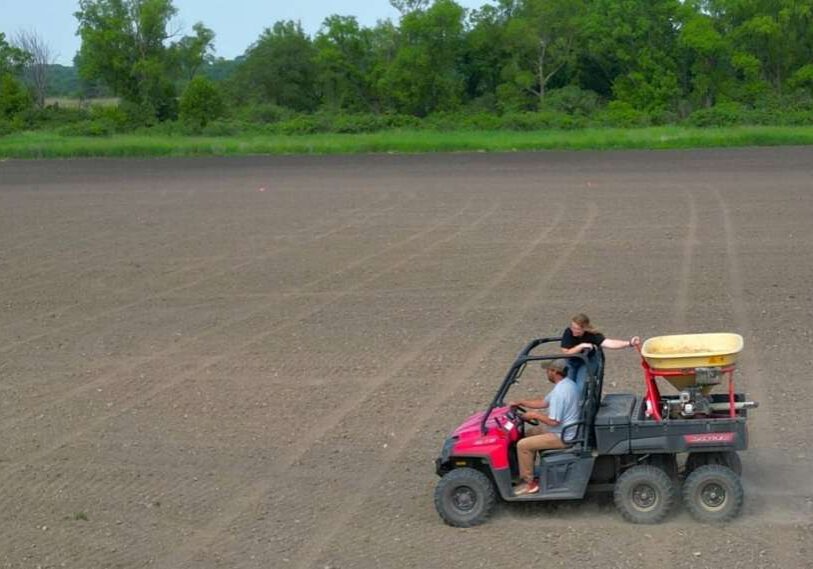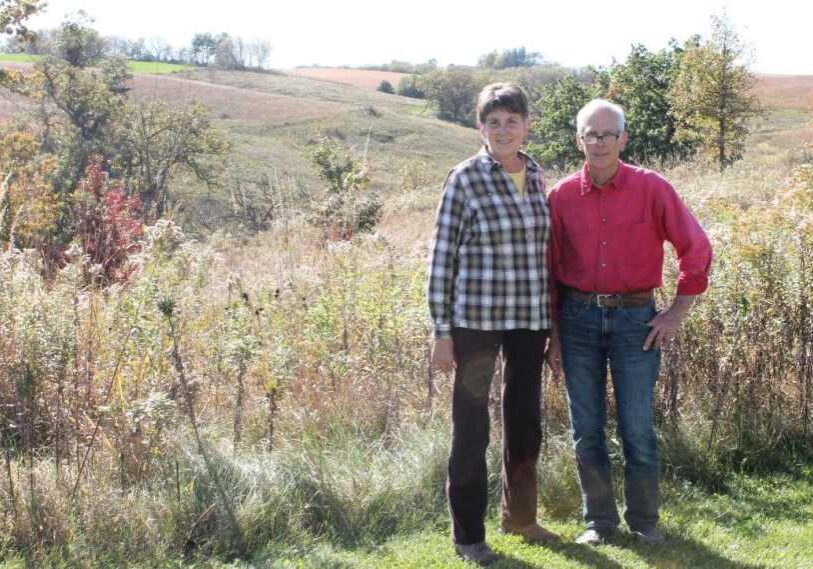Mound Prairie is a Refuge for Rare Native Plants

HOUSTON COUNTY — The mid-summer day was warm but not hot, making it tolerable when I stopped to again say hi to Mound Prairie, located along the Historic Bluff Country National Scenic Byway (Minnesota State Highway 16) midway between Houston and Hokah. That was good because it’s a goat prairie (so named because mountain goats would feel at home on their steep, rocky sides) that faces south and west and can get really hot in summer. But such prairies have evolved in the heat and can take it, its plants thriving when others would wither.
I parked in a small quarry off highway 16 and tried walking up a cool, wooded trail, hoping it would take me to the top and not require a frontal hike. All I saw was mosquitoes and gnats (and heard a grouse flush) so I opted for a direct hike up the steep side facing a golf course. It was just too steep, and I’m a lot older than I was the first time I hiked it, so I decided to just enjoy it from below.
Several species of wildflowers were blooming. I could see up the valley at the farmland and bluffs in the distance. Rock outcroppings were just right – and not too hot – to sit on to enjoy the view and look at a disappearing piece of southeast Minnesota natural history.
Much of that bluff, and two other sections of nearby woods and goat prairie, make up the Mound Prairie Scientific and Natural Area (SNA), more than 260 acres in all. SNAs, which are not as well known as state parks or wildlife management areas, protect “exceptional places where native plants and animals flourish; where rare species are protected; and where we can know, and study, Minnesota’s fascinating natural features,” according to the Minnesota Department of Natural Resources.
Unlike parks or Wildlife Management Areas (WMA), they have no developed recreational facilities but visitors are welcome to see the flowers, watch birds, walk or just loaf; taking anything off the SNAs is not allowed; a few, such as Queens Bluff goat prairie in Great River Bluff State Park north of La Crescent, are open by permit only.
There are maybe 20 SNAs in southeast Minnesota, ranging from flat prairie to goat prairie, to shaded woods to a place to protect roosting eagles. “Protection of multiple sites in each landscape region is a vital means of capturing the genetic diversity and preventing the loss of important species, communities, and features. This strategy observes the wisdom of not putting all our eggs in one basket,” the DNR wrote on its SNA web page.

Flowers of Leadplant, a common prairie flower, showed purples and orange/golds.
The DNR lists 61 plants that have been found on the site including common yarrow, ragweed, hog peanut, two kinds of thimbleweed, jack-in-the-pulpit and two kinds of milkweed; scores of bird species have been seen there.
When I told Scott Leddy about my problems getting to the top, he said I made a mistake in not following that wooded trail because it would have eventually taken me to the top where there are more flowers.
“It’s totally worth getting to the top,” said the local prairie expert who said he has helped restore about 22 goat prairies in the region. In spring, the summit of Mound Prairie is loaded with crocus and amethyst shooting star, it’s richer biologically than the steeper, more arid bluffside.
Changing Habitat
He said he knows Mound Prairie well because he grew up near it. “When I was a kid, I used to run up it and run down it,” Leddy said. Back then, a sand prairie at the base of Mound Prairie blossomed in flowers every year, he said. It’s now homes.
That shows a big problem with prairie in this region and across the state – it’s rare and getting rarer. The DNR says maybe one percent of the original prairie remains.
While people today see mostly woods on most slopes in this region, 200 years ago, the south- and west-facing slopes were mostly goat prairie that kept trees at bay with their heat as well as fires that were set naturally or by Native Americans. “Fire historically was real common here,” Leddy said. Smoke could be seen from fires far away. “The fires were huge.”
North- and east-facing slopes, and river bottoms, were mostly oaks, he said. When looking at records of what the region looked like back then “it’s mind blowing what the bluffs looked like,” he said.

Gray-headed Coneflowers blossomed in mid July at the base of Mound Prairie.
Also, the region had large herds of elk and bison that helped keep prairie open, he said. They were extirpated soon after Europeans began arriving in large numbers in the mid-1800s.
Without the fire and grazers, many bluffs were soon overgrown with brush and trees.
“It’s just tragic,” Leddy said. “It’s disgusting.” He’s called on state and federal resource agencies to do more to protect or restore the few remaining goat prairies.
Jeff Wilson, a DNR technician who helps manage SNAs in the southeast corner of Minnesota, said Mound Prairie was purchased beginning about 30 years ago because it had some rare or endangered species and it was of high quality. The wooded trail I had walked up isn’t formal, it’s just an old road.
He knows more work could be done managing Mound Prairie and other SNAs.
“We’re always behind,” he said. Right now, they are hiring more staff. “There is always more we wish we could do,” he said.
“We all absolutely love these sites and don’t want to see them overgrown.”
The SNA staff has worked with people from other departments to put together burn crews and have had animals graze it to keep down unwanted vegetation.
Managing goat prairies with burns is not always easy because they have rare species, as well as invasive species, Wilson said.
It’s “obviously problematic” because certain plants bloom in different seasons. “It’s kind of a juggling act,” he said. At the same time, “these sites evolved to be fire dependent.”
To further complicate management, the goat prairie has threatened or endangered species and it’s illegal to harm them so they have to avoid them at all costs, he said.
Besides the state protecting goat prairie and other prairies with SNAs, private landowners can enroll their prairies in the Native Prairie Bank that lets the DNR help the landowner manage the land, he said. It’s like a conservation easement.






